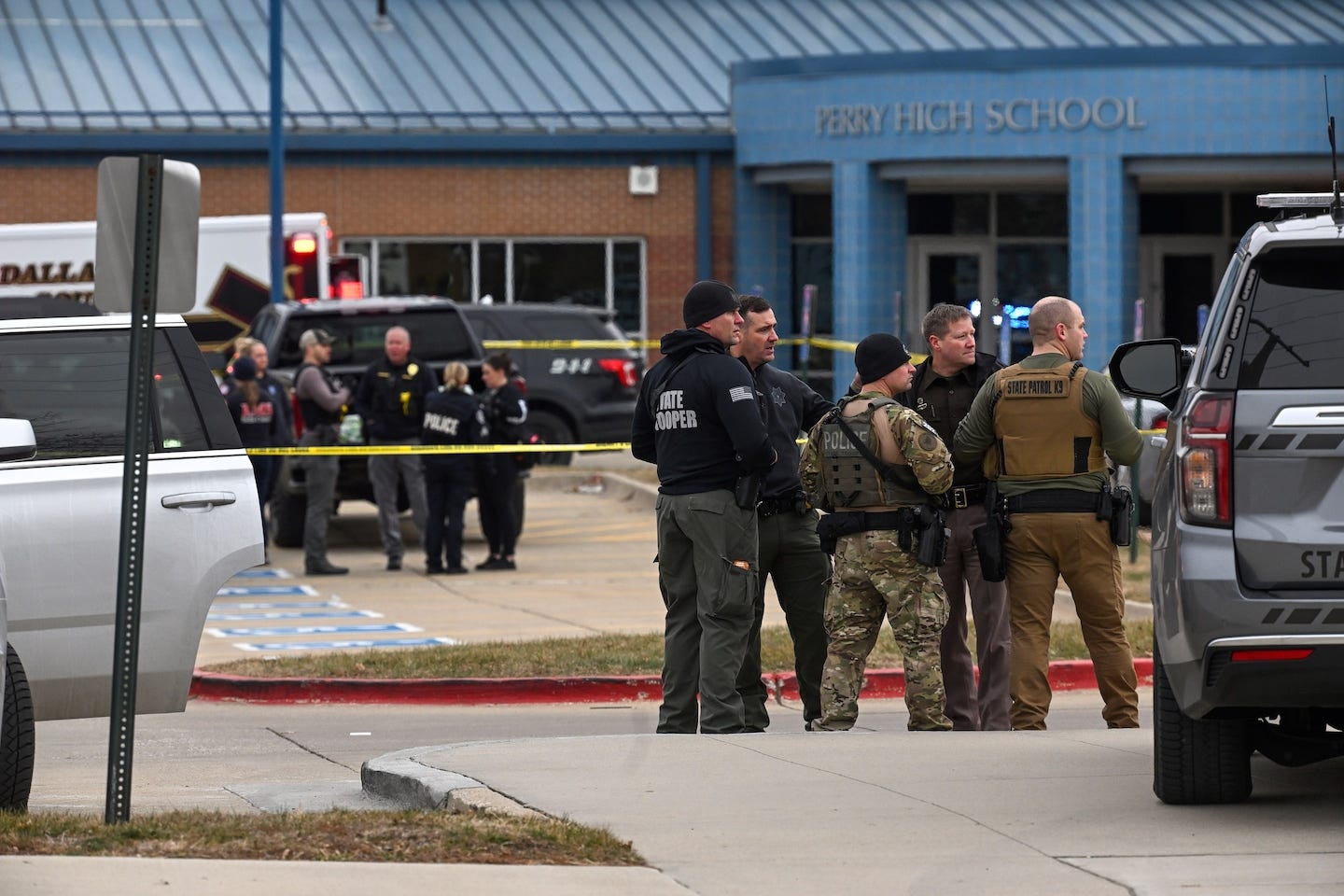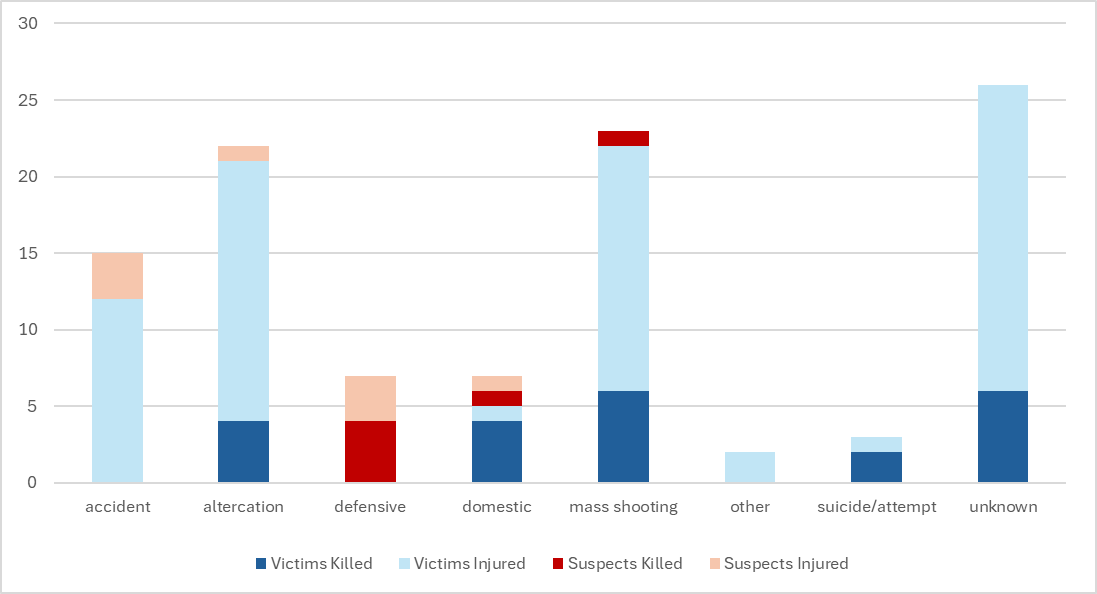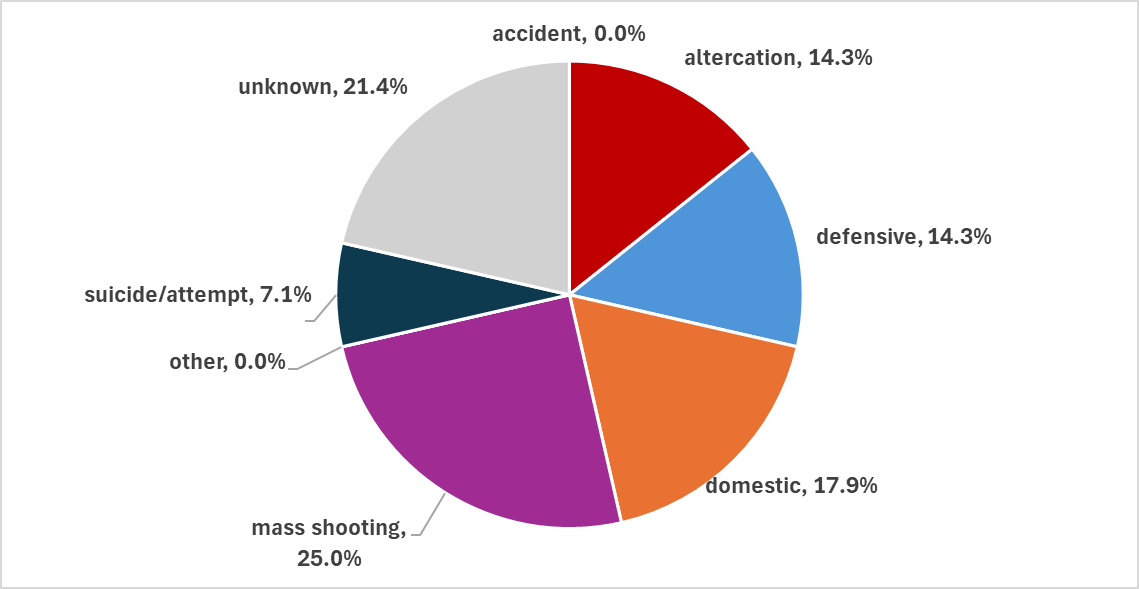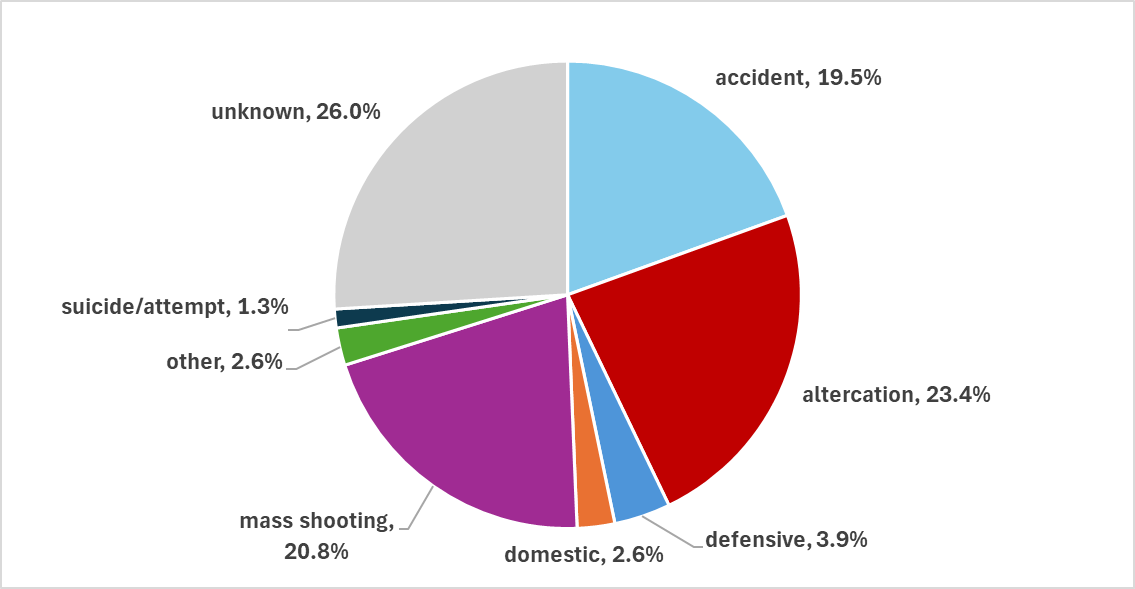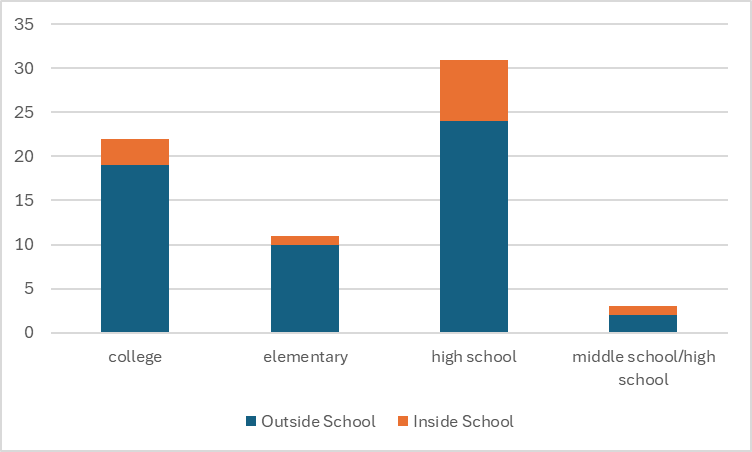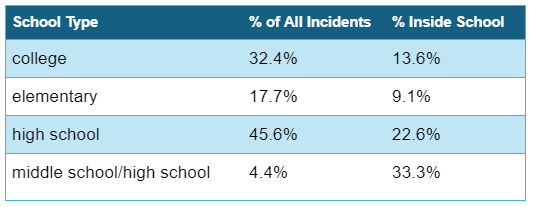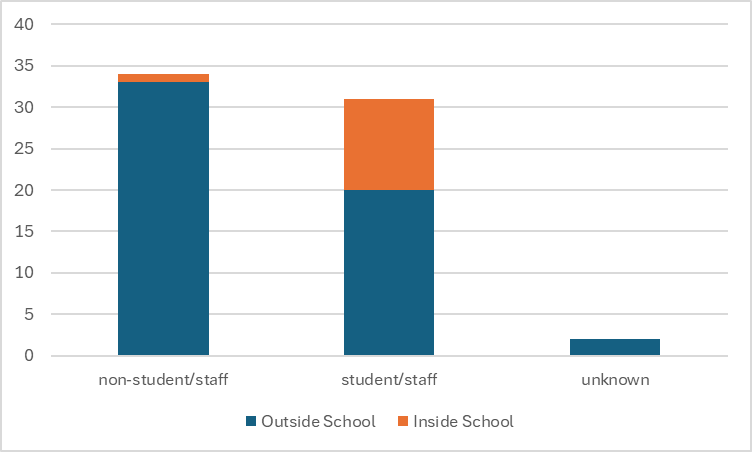Insights from 2024 School Shooting Data
Due to their shocking nature, school shootings have a nearly unique ability to spark contentious, passionate debates about gun control in the United States. Additionally, because they are disproportionately likely to harm children and other innocents, preventing school shootings should be a high priority for legislators, law enforcement, and ordinary citizens. Identifying the right prevention measures requires a better understanding of the nature of these incidents.
This article gives an overview of school shootings in the United States from January 1st, 2024 to September 26th, 2024 and presents data on deaths, injuries, location, type of shooting, people involved, and types of weapons used. This analysis yielded several informative results, some of which contradict common conceptions and rhetoric surrounding these tragedies:
When the sample is limited to instances with deaths or injuries, over 20% of the remaining violent shootings recorded as ‘school incidents’ in the Gun Violence Archive 2024 database do not meet the archive’s own definition of a school shooting.
There were 68 actual school shootings so far in 2024, resulting in 28 deaths (22 victims, 6 suspects) and 77 injuries (69 victims, 8 suspects).
For both victims and suspects, the median number of individuals killed per school shooting incident in 2024 was 0.
Of these 68 incidents:
3 were mass shootings, accounting for 25% of deaths and 21% of injuries from school shootings this year
24 were due to altercations, domestic disputes, robberies, or kidnappings
13 were accidents
7 were defensive (i.e., the only death/injury was the suspect)
3 were suicides or attempted suicides
In 55 (81%) of these incidents, the shooting took place exclusively outside school or college buildings.
In half of these incidents, the individuals shot did not include students or staff of the school where the shooting took place.
All but 4 incidents where the weapon type/types were known or made public exclusively involved handguns. Only 1 involved a rifle.
Source: Washington Post
Compiling incidents
The primary source for this article is the Gun Violence Archive (GVA), which compiles data on all types of gun violence incidents in the United States and claims to be a fairly comprehensive repository. They update their reports daily by surveying over 7,500 sources, including local and state police, media, and official government sources. There are other organizations that compile data on school shootings, but they either do not make their raw data publicly available or are not as comprehensive. I have reached out to the K-12 School Shooting Database for their raw data, but have not received a reply.
Most of the data used in this article come from the School Incidents report in the GVA repository, and the rest come from various media or police reports. The School Incidents report goes back to November of 2022, but most of the columns I use are not included in the GVA table and had to be manually added by reviewing media and police sources for each shooting. As a result, I have only compiled data from this year, but plan on eventually adding data from past years.
As of September 26th 2024, the GVA School Incidents report contains 717 incidents which took place this year. However, 630 (88%) of these incidents do not involve any death or injury to either the suspects or the victims. These non-violent incidents mostly consist of reports of guns being spotted or brandished on or near school property, or instances of guns discharging on or near school property but not injuring anyone. The GVA defines a school shooting as:
“An incident with death or injury that occurs on school property when students, faculty and/or staff are on the premises. Intent during those times are not restricted to specific types of shootings. Incidents that take place on or near school property when no students or faculty/staff are present are not considered ‘school shootings’.”
The term ‘school’ in this case includes colleges. By this definition, we’re left with 87 rows in the GVA report that could potentially qualify as school shootings.
Upon manual review of each incident, however, there are several more rows that should be dropped. The August 18th shooting at Mississippi Valley State University was erroneously included in the report twice under two separate incident IDs. There are also 18 incidents that, by the GVA’s own definition, do not qualify as school shootings. For example:
January 17th incident at Children’s Manor Montessori School: a snow plow driver was found in his car in the school parking lot with a fatal gunshot wound. Law enforcement officials stated that the shooting had nothing to do with the school and that the man could have been shot hours before being found, while no staff or students were present or while he was off school property.
April 22nd incident at the University of Alabama: a 35-year-old man with no connection to the university shot himself off campus in his own car during a police car chase. His car then happened to crash into a nearby UAB building, causing no damage to the building and no injuries to any bystanders.
May 10th incident at Richmond Technical Center: two adults, one of whom was a public school bus driver for Richmond, got in a fight near Richmond Technical Center outside of school hours and before the driver had started his shift. The fight escalated, and the driver discharged a firearm, injuring the other adult. Arguably, this could count as a school shooting under a looser definition since the shooter worked for the public school system, loosely qualifying as ‘staff’, but the shooting appears to have occurred near, not on, school property and occurred before any students or staff were on the premises.
June 28th incident at Ron Christopher Stadium: an adult man drove his truck into a ditch near a school baseball stadium, shot himself non-fatally in his own vehicle, then exited his truck and ran into the stadium. Neither the man nor the shooting had any connection to the school, and the shooting did not take place on school property.
Source: AL.com
All of the other incidents that I am excluding either occurred at bus stops (in general, not considered school property), occurred near school property rather than on it and did not involve students or staff, or involved students participating in a non-school related event such as a party or non-school sporting event. After dropping these rows, we are left with 68 school shootings so far in 2024. Lastly, I identified one incident, the April 22nd William Wiley Elementary School shooting, where both the suspect and the second victim were killed in a separate incident off school property later in the day. I have removed these two deaths from the total since they were not part of a school shooting.
Deaths or injuries by type of shooting
The 68 school shooting incidents this year account for 22 victim deaths, 69 victim injuries, 6 suspect deaths, and 8 suspect injuries. The mean number of victim deaths per incident was 0.32, and the mean number of victim injuries was 1.01. The mean number of suspect deaths per incident was 0.08, and the mean number of suspect injuries per incident was 0.11. For both victims and suspects, whether counted separately or together, the median number of deaths per incident was 0.
Figure 1: Number of Deaths/Injuries by Type of Shooting
Unknown
Based on my manual review of the incidents, 18 (26.5%) of this year’s shootings are not known to be either accidental or intentional, or the suspect and motive for the shooting are not known or made public. These ‘unknown’ shootings account for 6 deaths and 20 injuries.
Example: In the April 21st Shooting at Delaware State University, an 18-year-old woman who was not a student at the university was shot and killed on school property by two young men who were also not students. There was no reported altercation, and police reported that the victim may have not been the intended target. Both suspects were arrested and charged.
Source: WBOC
Altercations (non-domestic)
The most common category of shooting where the motive is known was altercations (25.0%) which, not including domestic disputes, accounted for 4 deaths and 18 injuries. These include fights or confrontations that escalate into the intentional discharge of a firearm on school property, whether by a student or non-student.
Example: In the January 30th shooting at Grant Union High School, a 14-year-old allegedly walked up to a 17-year-old in the parking lot of the school, provoked him, attempted to scare him with a gun, then shot him non-fatally. The suspect was arrested.
Figure 2: Share of School Shooting Incidents by Type
Accidents
The next most common category was accidents (19.1%), accounting for 0 deaths and 15 injuries. These include instances of accidental or negligent discharge of a firearm on school property, whether by a student, law enforcement officer, security personnel, parent, or other non-student.
Example: On March 4th at the Murray State College Firing Range, a student accidentally shot himself in the leg non-fatally during ‘shotgun practice’. He was taken to a local hospital and survived.
Defensive shootings
Defensive shootings accounted for 10.3% of shooting incidents, resulting in 4 deaths and 3 injuries. These include instances where the only death or injury was the suspect. In this sample, these happen to consist exclusively of law enforcement or security personnel shooting suspects who are behaving violently or threatening others.
Example: On April 22nd at Suncoast Community High School, a non-student adult attacked a school security officer after trespassing onto school property. The officer then shot the man non-fatally in the leg.
Domestic shootings
Domestic incidents accounted for 7.4% of school shootings, 5 deaths, and 2 injuries. These include altercations between couples, spouses, or other family members that escalated into the intentional discharge of a firearm on school property.
Example: On September 23rd at Cessna Elementary School, a husband and wife were brought to the school along with their kids by a Lyft driver. A domestic dispute allegedly ensued, during which the husband shot the wife in the chest, chased her down, and pointed the gun at her head. A local deputy then intervened, shooting the husband. Both the husband and wife survived and were taken to the hospital.
Figure 3: Share of School Shooting Deaths by Type
Mass shootings
Mass shootings, defined as “four or more shot and/or killed in a single event [incident], at the same general time and location, not including the shooter”, account for 4.4% of all school shootings this year, but obviously make up a disproportionately large share of deaths and injuries (7 and 16, respectively). The three mass school shootings this year were the Perry Middle and High School Shooting, which, including the suspect, left 3 dead and 5 injured, the Benjamin E. Mays High School Shooting, which left 0 dead and 4 injured, and the Apalachee High School Shooting, which left 4 dead and 7 injured.
Example: On September 4th at Apalachee High School, a 14-year-old student brought an AR-15 to his high school and opened fire on teachers and students, killing 4 and injuring 7 according to the GVA entry. The shooter was then engaged and arrested by school resource officers.
Source: Barrow County Sheriff’s Office
Suicides and suicide attempts
Suicides and suicide attempts also made up 4.4% of school shootings but account for only 2 deaths and 1 injury. These include instances of intentional, self-inflicted gunshot wounds, whether fatal or non-fatal.
Example: On April 19th at Tulane Medical University, an employee of the college attempted unsuccessfully to kill himself with a gun in the school’s medical laboratory.
Figure 4: Share of School Shooting Injuries by Type
Other
Robberies, kidnappings, and other non-murder violent crimes made up 2.9% of shootings and accounted for 0 deaths and 2 injuries.
Example: On September 15th, an adult non-student kidnapped a man and woman off school property and forced them to drive him to a football game on Harvey Austin Elementary School property where he then robbed two people at gunpoint, shot one adult, and attempted to flee the scene with the woman still in the vehicle. He was apprehended and charged with kidnapping and attempted murder. All persons involved were non-student adults.
Table 1: Share of Incidents, Deaths, and Injuries by Shooting Type
Location, student/staff involvement, and weapon type
Of the 68 incidents this year, 31 (45.6%) occurred at high schools, 22 (32.4%) occurred at colleges, 11 (17.7%) occurred at elementary schools, and 3 (4.4%) occurred at schools that teach both elementary and high school grades.
Figure 5: Number of School Shootings by Location and School Type
In 12 (17.6%) of school shootings in this dataset, the shooting took place inside a school or college building. The majority of shootings took place in parking lots, outdoor sport facilities (basketball courts, baseball stadiums, football fields, etc.), or other outdoor areas on school property.
Table 2: Share of Incidents by Location
For half of the shootings in this dataset, the individuals shot were confirmed to be neither students nor staff of the school where the shooting took place. For 3 of the shootings, it is unknown whether the individuals shot were students or staff. The most common types of shooting in terms of location and student/staff involvement were incidents that took place outside of the school and involved neither students nor staff.
Figure 6: Number of School Shooting Instances by Location and Student/Staff Involvement
Note: College dormitories are not considered ‘inside school’, but are considered school property
The type of weapon/weapons involved in the shooting is usually not known or made public. In only 22 of this year’s incidents does the GVA or any available media source identify the types of weapons used in the shooting. For instances where the weapon types are known, all but 4 involved handguns exclusively.
In the Apalachee High School mass shooting, the shooter used an AR-15. In the Mount Horeb Middle School shooting, the student who was shot by law enforcement apparently had a pellet rifle, not a firearm. The law enforcement officers presumably used handguns to shoot the student, but I could not find confirmation of this. In the Murray State College Firing Range accident, the student who shot himself accidentally was participating in a shotgun training course, so presumably he used a shotgun. Lastly, in the Perry shooting, the shooter used a handgun and a pump-action shotgun.
Discussion
As mentioned, I plan on adding earlier years of data to this analysis as time allows, but I also would like to do a similar analysis for all mass shootings. For now, there are only three conclusions about school shootings in general that I feel entitled to draw from this data:
First, most of these incidents do not fit into the image the average person conjures when they hear the term ‘school shooting’. Most people probably picture a mentally troubled child bringing a rifle into their own school and indiscriminately killing other students or staff. However, only 1 of these 68 shootings is known to have involved a rifle, over 80% of these shootings occurred outside of school buildings, and about half do not involve students or staff of the school where the shooting occurred. The bulk of school shooting data points I reviewed were essentially random people who happen to have committed their crime on or near a school, or were not malicious incidents at all (accidents, defensive shootings, suicides, or suicide attempts).
Second, the definition of ‘school shooting’ used by organizations like the GVA is too broad for these types of data sets to be used for their intended purpose, at least without more relevant characteristics being included in the data. It should be easy to, without having to resort to third party reports, distinguish between a negligent discharge at a gun range, a suicide in the parking lot, a random fight between non-students that happens to have occurred at a school basketball game, a man who shot himself during a car chase and then careened into a nearby university building, and a child who brought a rifle into his school to murder his fellow students. These different types of incidents require different types of deterrents, so lumping them all in as ‘school shootings’ is obstructive to the goal of reducing gun violence.
Lastly, many of the measures commonly taken to reduce these incidents are likely to have no effect on most types of school shootings, and some may actually increase certain types. For example, installing metal detectors at school entrances may help prevent firearms discretely entering the building, but most school shootings take place outside. Hiring armed security to patrol the perimeter may help deter would-be shooters from entering the premises, but also increases the chance of firearm accidents, which account for almost a fifth of school shootings. Making schools into gun-free zones may reduce firearm accidents on school property, but will do nothing to stop malicious premeditated shootings and will diminish the likelihood of an armed adult bystander intervening in an attack. The correct remedy for gun violence at schools should be found by assessing which types of shootings are most likely to occur, which types can be prevented, and which preventative measures are likely to minimize the loss of innocent life.
Feel free to email me at mikehowardjr@protonmail.com for the data or code used in this article.

